First clinical study shows potential of stem cell-enriched fat grafts to transform reconstructive surgery
 Stem cell-enriched fat grafting could become central to plastic and reconstructive surgery after the first randomised trial in humans confirms the technique’s excellent feasibility and safety.
Stem cell-enriched fat grafting could become central to plastic and reconstructive surgery after the first randomised trial in humans confirms the technique’s excellent feasibility and safety.
“Our promising results suggest that stem-cell enriched fat grafting might prove to be an attractive alternative to major tissue augmentation, such as breast reconstruction after cancer with allogeneic material or major tissue flap surgery, with fewer side effects and more satisfying cosmetic results”*, explains Dr Stig-Frederik Trojahn Kølle, a member of the research team from Copenhagen University Hospital in Denmark, in The Lancet.
Increasingly, autologous fat grafting or lipofilling, in which an individual’s own fat is harvested to increase the volume of fat in another area of their body, is being used in reconstructive surgery, with the majority of board certified plastic surgeons in the USA who do breast reconstruction using this technique.
But despite the technique’s potential, resorption rates (the percentage of the transferred fat that does not survive) of up to 80% have been reported. Recent animal studies have shown that fat grafts enriched with culture-expanded adipose [fat]-derived stem cells (ASCs) can substantially improve graft survival.
In this study, the survival of fat grafts enriched with culture-expanded autologous ASCs was compared with traditional non-enriched fat grafts (control) in 10 healthy volunteers.
Volunteers underwent liposuction to collect fat tissue from one side of the abdomen. Two purified fat grafts were prepared for each participant and injected in the upper arms—one enriched with their own stem cells and the other without (control). The volumes of injected fat grafts were measured by MRI immediately after transplant, and just before the grafts were removed after 121 days.
The cell-treated grafts retained 80•9% of the initial volume compared with 16•3% for the control grafts, with significantly higher amounts of adipose tissue and newly formed connective tissue, and significantly less necrosis 4 months after the transplant.
According to Dr Trojahn Kølle, “These promising results add significantly to the prospect of stem cell use in clinical settings and show that ASC graft enrichment could render lipofilling a reliable procedure, since the resorption rate, quality of tissue, and safety can be predicted.”
Writing in a linked Comment, J Peter Rubin and Kacey G Marra from the University of Pittsburgh in the USA say, “These therapies could revolutionise breast reconstruction after cancer and reconstruction of deformities after trauma, for example.”
However, they add, “A crucial open question that will affect use of this therapy is whether there is an optimum cell dose for efficacy, and/or if there is a critical threshold cell dose for therapeutic effect…Another unresolved issue for this therapy is whether high concentrations of stem cells can stimulate the growth of residual breast cancer cells…This issue will be best addressed in large clinical
trials.”
Source: The Lancet

